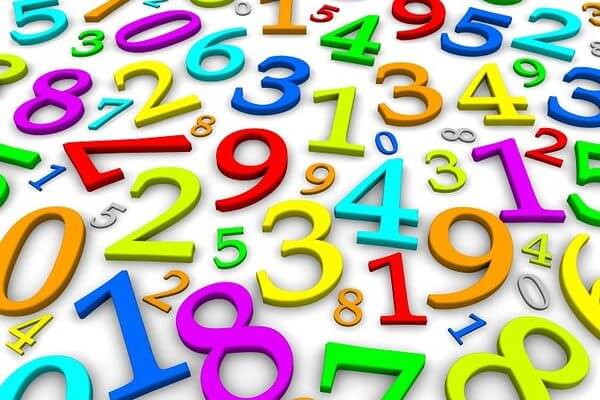Cardinal numbers (números cardinais) O que são? Quais são? Lista completa!
Conhecer os números cardinais em inglês é de suma importância. Isso porque eles estão presentes em grande parte do que falamos durante o dia: tudo o que envolve a contagem de alguma coisa, é preciso fazer uso dos números cardinais.
Convencido da importância deles? Pois confira este artigo do Sim para todos a respeito justamente deles, dos famosos cardinal numbers!

O que são os “cardinal numbers”?
Os cardinal numbers (números cardinais) são palavras usadas para se indicar a quantidade de elementos de um determinado conjunto, ou seja, para contar. Eles são usados para responder à seguinte questão: “quantos?”.
Confira alguns exemplos para compreender melhor:
(1) I have only two pairs of socks (Eu tenho apenas dois pares de meias)
(2) I’m twenty-one years (Eu tenho vinte-e-um anos).
Observe que, nestes exemplos, os números em negrito, escritos na forma extensa, estão sendo usados para indicar a quantidade de elementos de determinado conjunto: em (1), a quantidade de elementos – meais – em um conjunto – número de meias que o sujeito tem–; o mesmo em (2), sendo o elemento a ser contado o número de anos, e o conjunto a quantidade de anos já vividos.
Diferença entre “cardinal number” e “ordinal number”
Os números cardinais diferem-se dos números ordinários porque estes são usados para se indicar uma ordem (daí o nome, ordinário) ou uma hierarquia numa determinada sequência. Os números cardinais, como vimos, indicam a quantidade de elementos, sem fazem menção à posição em que ocupam. Veja a comparação:
(1) Dom Pedro I was the first emperor of Brazil (“Dom Pedro I foi o primeiro imperador do Brasil);
(2) Brazil had just two emperors: Dom Pedro I and his son Dom Pedro II (“O Brasil teve apenas dois imperadores: Dom Pedro I e seu filho Dom Pedro II”).
Perceba que, em (1), o número em negrito está fazendo referência à posição de Dom Pedro I na hierarquia de imperadores da história do Brasil. Trata-se, portanto, de um número ordinário.
Já em (2), o número destacado não está fazendo referência à posição dos imperadores, mas sim à quantidade de imperadores (de elementos) dentro do conjunto de “imperadores do Brasil”. Trata-se, portanto, de um número cardinal.
Os números cardinais são escritos da seguinte maneira: 1/one, 2/two, 3/three, 4/four…
Os números ordinários, por sua vez, são escritos assim: 1st/first, 2nd/second, 3rd/third, 4th/fourth…

Lista de números cardinais
- 0 – Zero
- 1 – One
- 2 – Two
- 3 – Three
- 4 – Four
- 5 – Five
- 6 – Six
- 7 – Seven
- 8 – Eight
- 9 – Nine
- 10 – Ten
- 11 – Eleven
- 12 – Twelve
- 13 – Thirteen
- 14 – Fourteen
- 15 – Fifteen
- 20 – Twenty
- 21 – Twenty-one
- 22 – Twenty-two
- 23 – Twenty-three
- 24 – Twenty-four
- 25 – Twenty-five
- 30 – Thirty
- 40 – Fourty
- 50 – Fifty
- 60 – Sixty
- 70 – Seventy
- 80 – Eighty
- 90 – Ninety
- 100 – One hundred/A hundred
- 101 – One hundred and one/A hundred and one/A hundred one/One hundred one
- 102 – One hundred and two
- 103 – One hundred and three
- 104 – One hundred and four
- 105 – One hundred and five
- 110 – One hundred and ten
- 200 – Two hundred
- 300 – Three hundred
- 400 – Four hundred
- 500 – Five hundred
- 1,000 – One thousand
- 1,001 – One thousand and one
- 1,002 – One thousand and two
- 1,003 – One thousand and three
- 1,004 – One thousand and four
- 1,005 – One thousand and five
- 1,100 – One thousand and hundred
- 1,101 – One thousand and hundred one
- 1,102 – One thousand and hundred two
- 1,103 – One thousand and hundred three
- 1,104 – One thousand and hundred four
- 1,105 – One thousand and hundred five
- 10,000 – Ten thousand
- 10,001 – Ten thousand and one
- 10,002 – Ten thousand and two
- 10,003 – Ten thousand and three
- 10,004 – Ten thousand and four
- 10,005 – Ten thousand and five
- 10,100 – Ten thousand and one hundred
- 10,200 – Ten thousand and two hundred
- 10,300 – Ten thousand and three hundred
- 10,400 – Ten thousand and four hundred
- 10,500 – Ten thousand and five hundred
- 11,000 – Eleven thousand
- 12,000 – Twelve thousand
- 13,000 – Thirteen thousand
- 14,000 – Fourteen thousand
- 15,000 – Fifteen thousand
- 100,000 – One hundred thousand
- 100,001 – One hundred thousand and one
- 100,002 – One hundred thousand and two
- 100,003 – One hundred thousand and three
- 100,004 – One hundred thousand and four
- 100,005 – One hundred thousand and five
- 100,100 – One hundred thousand and one hundred
- 100,200 – One hundred thousand and two hundred
- 101,000 – One hundred thousand one
- 110,000 – One hundred and ten thousand
- 200,000 – Two hundred thousand
- 300,000 – Three hundred thousand
- 400,000 – Four hundred thousand
- 500,000 – Five hundred thousand
- 1,000,000 – One million









Deixe seu comentário